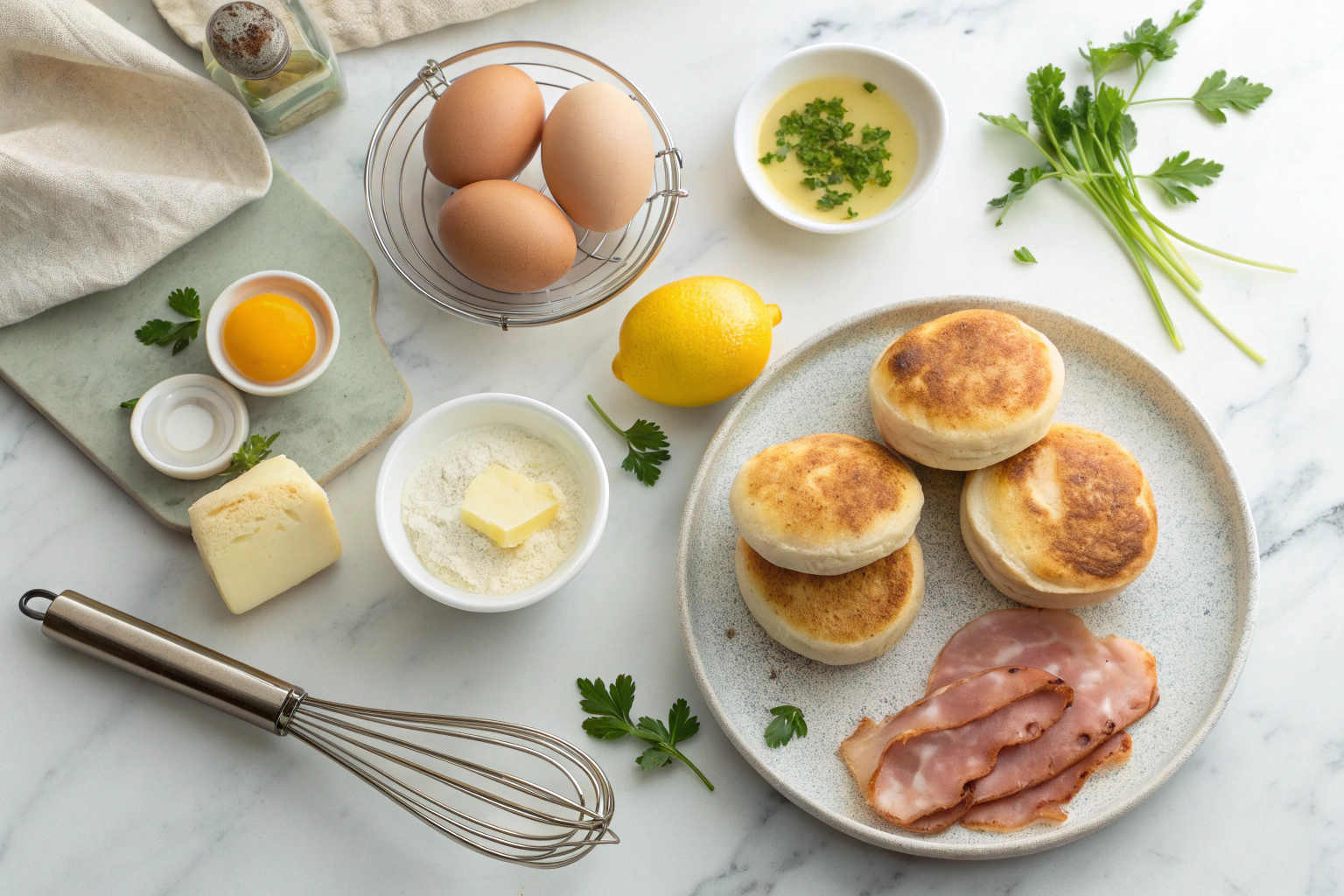Perfect Homemade Eggs Benedict Recipe (With Foolproof Hollandaise Sauce)

If you’ve ever ordered Eggs Benedict at a café and wondered how to recreate that silky, golden perfection at home, this recipe is your answer. Combining poached eggs, crisp Canadian bacon, buttery English muffins, and a luscious hollandaise sauce, this classic dish is the definition of a luxurious breakfast.
Although it looks fancy, making Eggs Benedict is entirely doable for home cooks. With the right timing, a few tricks, and patience, you’ll turn your kitchen into a brunch haven.
The Secret Behind Perfect Eggs Benedict
The magic of this dish lies in the balance of textures and flavors. The hollandaise sauce, rich and lemony, complements the soft poached egg and the savory bacon. When your fork pierces the yolk, the creamy sauce and golden yolk mingle together, coating every bite with buttery goodness.
Hollandaise sauce is an emulsion — meaning butter and egg yolks are whisked together carefully so they don’t separate. Meanwhile, poached eggs add the signature runny yolk that gives the dish its charm.
Ingredients

For the Hollandaise Sauce
-
3 large egg yolks
-
1 tablespoon lemon juice (freshly squeezed)
-
½ cup unsalted butter, melted and warm
-
¼ teaspoon salt
-
1 pinch cayenne pepper (optional)
For the Eggs Benedict
-
4 large eggs
-
2 English muffins, split and toasted
-
4 slices Canadian bacon (or ham)
-
1 tablespoon white vinegar (for poaching water)
-
1 tablespoon unsalted butter
-
Fresh parsley or chives, for garnish
Step-by-Step Instructions
Step 1: Make the Hollandaise Sauce
First, set up a double boiler by placing a heatproof bowl over a pot of simmering water. Make sure the water doesn’t touch the bowl’s bottom.
Whisk together egg yolks and lemon juice until thick and pale. Then, slowly drizzle in the melted butter while whisking constantly. The sauce should become smooth, glossy, and slightly thick.
Season with salt and a touch of cayenne pepper. If it gets too thick, whisk in a teaspoon of warm water.
Pro Tip: Keep your hollandaise warm, not hot. Place it over barely warm water or in a thermos so it doesn’t curdle.
Step 2: Toast and Prepare the Muffins
While the sauce rests, toast the English muffins until golden brown. Spread a bit of butter on each half to give them a rich base.
In a skillet, cook Canadian bacon until the edges turn crisp. Set aside on a plate lined with paper towels.
Step 3: Poach the Eggs
Fill a medium saucepan with water and bring it to a gentle simmer. Add 1 tablespoon of white vinegar — it helps the egg whites set quickly.
Crack each egg into a small cup, then gently slide it into the water. Cook for 3 to 4 minutes, until the whites are firm but the yolks remain soft.
Remove with a slotted spoon and drain briefly on paper towels.
Pro Tip: Swirling the water gently before adding the eggs helps them form a neat shape.
Step 4: Assemble the Eggs Benedict
To assemble, place toasted muffin halves on each plate. Top each with a slice of Canadian bacon, then a poached egg.
Finally, spoon warm hollandaise sauce generously over the eggs, letting it cascade down the sides. Sprinkle with fresh parsley or chopped chives for a finishing touch.
Step 5: Serve Immediately

Eggs Benedict is best enjoyed the moment it’s made. Serve it warm alongside fresh fruit, roasted potatoes, or a simple green salad for a perfect brunch spread.
Flavor Variations
-
Spicy Benedict: Add a dash of hot sauce to the hollandaise or sprinkle chili flakes on top.
-
Florentine Style: Replace the bacon with sautéed spinach for a lighter, vegetarian twist.
-
Smoked Salmon Benedict: Swap bacon for smoked salmon and garnish with dill for a luxurious touch.
-
Avocado Benedict: Layer slices of creamy avocado between the muffin and egg for a California vibe.
-
Crab Benedict: Top with lump crab meat and a squeeze of lemon juice for a seafood delight.
Each variation follows the same base steps but adds a unique flair that keeps this classic dish exciting.
Storage & Reheating Tips
Eggs Benedict is best eaten fresh. However, here’s how to manage leftovers:
-
Hollandaise Sauce: Store in an airtight container in the refrigerator for up to 2 days. Reheat gently over warm water while whisking constantly.
-
Poached Eggs: You can make them ahead, store them in cold water in the fridge for up to 1 day, and reheat in hot (not boiling) water for 30 seconds.
-
Muffins & Bacon: Toast and cook fresh for best texture.
Avoid microwaving hollandaise or poached eggs — the texture will break or overcook.
Common Mistakes & How to Avoid Them
-
Sauce Breaking: If the hollandaise separates, whisk in a teaspoon of warm water or another yolk to re-emulsify.
-
Overcooked Eggs: Simmer gently, don’t boil. Boiling water causes tough whites and hard yolks.
-
Cold Butter: Always melt the butter before whisking it into the yolks to keep the sauce smooth.
-
Timing Errors: Prep your ingredients before poaching eggs so you can serve everything hot.
By pacing each step and staying patient, you’ll consistently get picture-perfect results.
Why This Recipe Works
-
Balanced flavors: The tart lemon in the hollandaise cuts through the richness of the butter and egg.
-
Stepwise precision: Each step complements the next — from toasting to poaching — ensuring consistent results.
-
Simple ingredients, gourmet results: You don’t need fancy tools, just technique and timing.
-
Adaptable for all tastes: From classic to modern variations, it suits every brunch table.
Final Thoughts
Eggs Benedict is a breakfast classic that feels restaurant-worthy yet completely achievable in your home kitchen. With patience and the right technique, you’ll master the creamy hollandaise, soft poached eggs, and buttery muffins that define this dish.
Whether you serve it on a lazy Sunday morning or impress guests at a brunch gathering, this Eggs Benedict recipe will always steal the spotlight — one golden yolk at a time.

